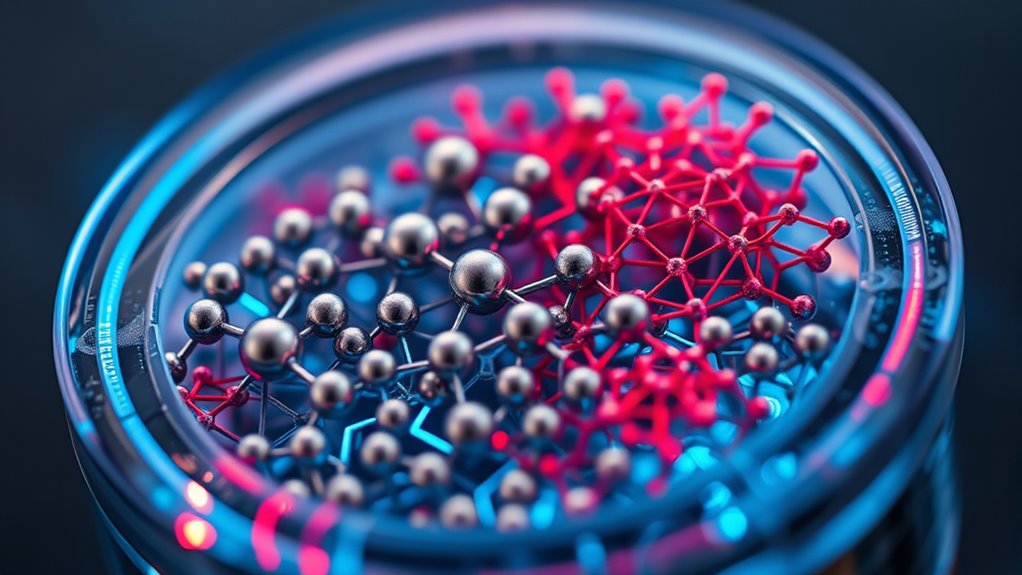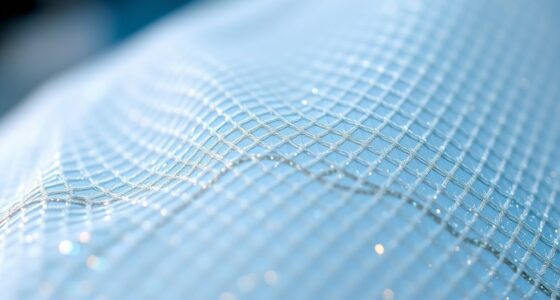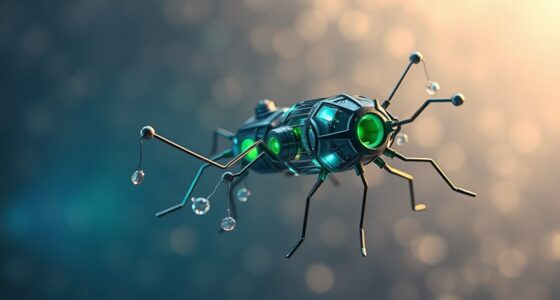Nanomachines markedly boost energy storage by making batteries and supercapacitors faster, longer-lasting, and more efficient. They use nanostructures and materials like graphene and nanotubes to increase surface area, improve charge transfer, and reduce degradation. This allows for quicker charging, higher power density, and better durability. As innovations grow, these tiny machines help create lighter, eco-friendly energy solutions. Keep exploring to discover how ongoing advancements could transform your energy devices even further.
Key Takeaways
- Nanomachines enhance energy storage by enabling precise control of electrochemical reactions, increasing efficiency and charge/discharge speeds.
- Nanostructured electrode materials like nanowires and nanoparticles boost surface area, improving capacity and device longevity.
- They reduce ion diffusion distances, facilitating faster charging and discharging in batteries and supercapacitors.
- Nanomaterials such as graphene and carbon nanotubes improve electrical conductivity and mechanical stability of energy devices.
- Innovations like self-assembling nanocomposites and biomimetic designs increase durability and enable smarter energy management systems.
The Role of Nanomachines in Modern Energy Storage

Nanomachines are revolutionizing energy storage by enabling more efficient and compact systems. You can see how their tiny size allows for precise control of chemical reactions, leading to faster charge and discharge cycles. These nanomachines can be integrated directly into batteries and supercapacitors, enhancing their overall performance. By manipulating individual molecules, they help optimize energy transfer and reduce losses, making storage devices more reliable. Their ability to operate at the nanoscale also means you can design systems that are lighter and take up less space, ideal for portable electronics and electric vehicles. Additionally, nanoscale control allows for the fine-tuning of electrochemical processes, further improving efficiency. As a result, nanomachines are paving the way for smarter, more efficient energy solutions that meet the growing demand for sustainable power sources.
How Nanostructures Enhance Battery Performance
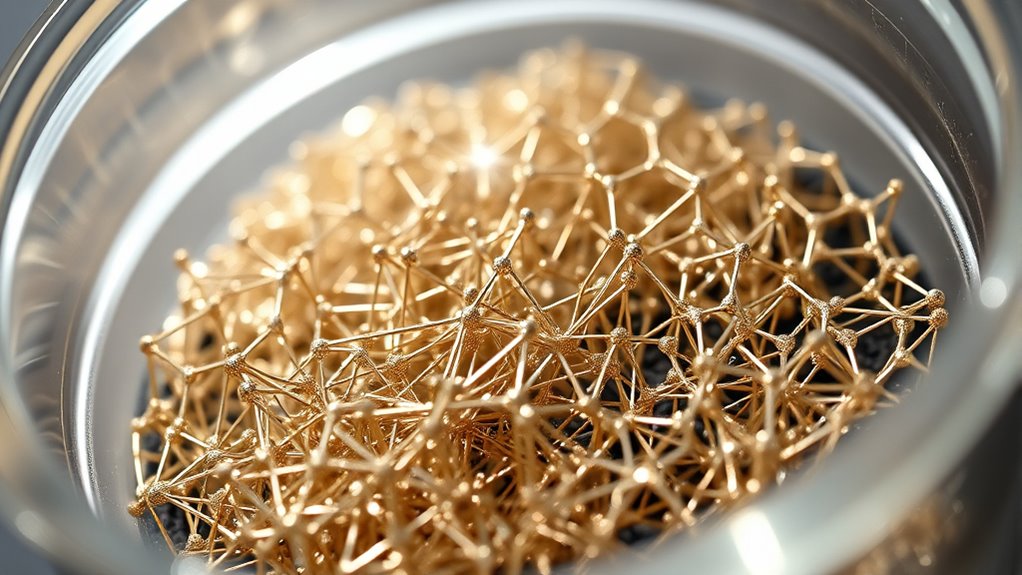
Nanostructures increase the surface area of battery materials, allowing for more active sites and improved energy storage. This leads to faster charge and discharge cycles, making batteries more efficient. By optimizing these nanostructures, you can markedly boost overall battery performance.
Increased Surface Area
Because increasing the surface area of electrode materials allows for more active sites, nanostructures considerably boost battery performance. With a larger surface, you enable more reactions to occur simultaneously, improving charge capacity and energy density. Nanostructured materials, such as nanowires or nanoparticles, present a greater interface between the electrode and electrolyte, facilitating faster ion exchange. This expanded surface also enhances the electrode’s ability to accommodate volumetric changes during charging and discharging, reducing degradation. As a result, batteries with nanostructured electrodes tend to last longer and deliver higher power output. By engineering materials at the nanoscale, you optimize the contact area, making your batteries more efficient, responsive, and capable of meeting demanding energy storage needs. Additionally, integrating AI-driven analytics can help optimize nanomaterial design for better performance.
Faster Charge/Discharge
By reducing the diffusion path for ions and electrons, nanostructured materials enable batteries to charge and discharge much more rapidly. When you incorporate nanomaterials, the shorter distances allow ions to move quickly through electrodes, minimizing delays caused by sluggish diffusion. This means faster energy transfer and reduced charging times. Nanostructures also improve electrical conductivity, helping electrons flow more efficiently. As a result, batteries can handle higher current rates without overheating or degrading quickly. Additionally, the increased surface area of nanomaterials provides more active sites for electrochemical reactions, further speeding up charge and discharge cycles. These advancements make nanostructured batteries ideal for applications requiring rapid energy replenishment, such as electric vehicles and portable electronics, enhancing overall performance and user experience.
Nanomaterials in Supercapacitors: Advantages and Challenges

Nanomaterials in supercapacitors offer a larger surface area that boosts energy storage capacity and enhances charge transfer. They also improve conductivity, leading to faster performance. However, manufacturing these advanced nanomaterials remains challenging, affecting scalability and practical application. Additionally, ongoing research focuses on overcoming manufacturing challenges to facilitate broader adoption and commercialization of these technologies.
Enhanced Surface Area
Enhancing the surface area of nanomaterials is essential for improving supercapacitor performance, as it directly increases the electrode’s capacity to store charge. A larger surface area provides more active sites for charge accumulation, boosting energy storage. To achieve this, you can:
- Use nanostructured materials like nanotubes, nanowires, or porous frameworks to maximize surface exposure.
- Incorporate high-surface-area materials such as activated carbon or graphene derivatives.
- Optimize synthesis methods to create finer, more dispersed nanomaterials without agglomeration.
These strategies help you increase charge storage capacity, improve power density, and enhance overall efficiency. However, balancing surface area with stability remains a challenge, requiring careful design to prevent material degradation over time.
Improved Conductivity
Have you ever wondered why conductivity is essential in supercapacitors? High conductivity allows electrons to move quickly between the electrode and electrolyte, enabling rapid charging and discharging. Nanomaterials, like graphene and carbon nanotubes, substantially boost conductivity by providing highly conductive pathways. These materials create interconnected networks that reduce resistance, improving energy transfer efficiency. Enhanced conductivity directly translates to better power density and faster response times, which are vital for applications requiring quick bursts of energy. Using nanomaterials also helps maintain stability during repeated charge cycles, ensuring longevity. However, achieving uniform dispersion and strong connections at the nanoscale remains challenging. Still, improving conductivity through nanomaterials releases the full potential of supercapacitors, making them more efficient and responsive energy storage devices.
Manufacturing Difficulties
Why is it so challenging to manufacture nanomaterials for supercapacitors? The process requires precise control over size, shape, and surface properties to guarantee ideal performance. If you don’t, you risk inconsistent quality and reduced efficiency. Here are the main difficulties:
- Achieving uniformity at the nanoscale, which demands advanced techniques and tight quality control.
- Scaling up production without losing nanostructure integrity, making mass manufacturing complex and costly.
- Ensuring safety and sustainability, as nanomaterials can pose health and environmental risks if not handled properly.
- Additionally, the integration of nanomaterials with existing automation systems in manufacturing poses further challenges for consistent production.
These challenges make it difficult to produce reliable, cost-effective nanomaterials suitable for commercial supercapacitors, hindering widespread adoption.
Innovations in Nanomachine Design for Energy Applications
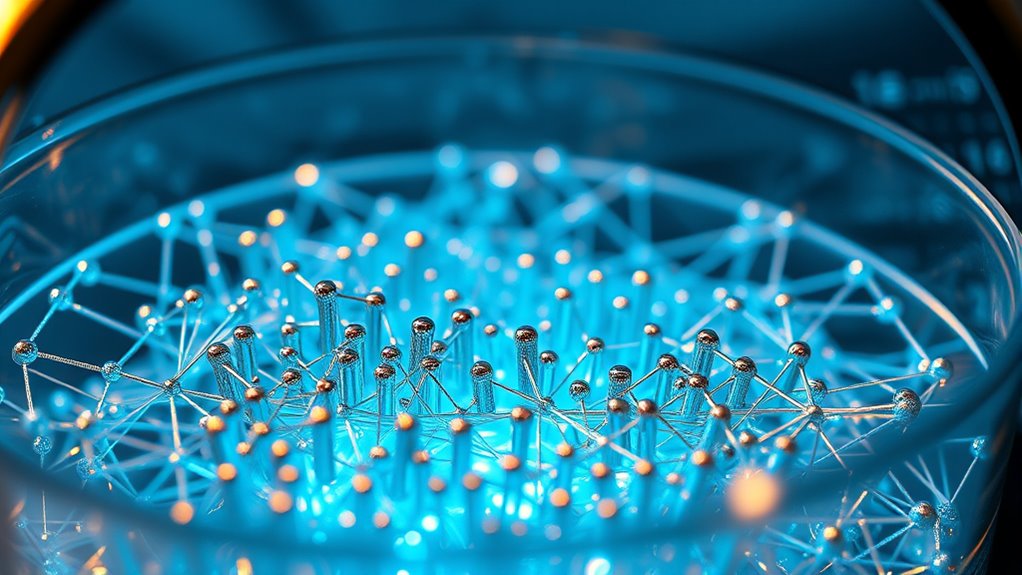
Recent advances in nanomachine design are transforming energy storage technologies by enabling more efficient and scalable solutions. Researchers develop innovative architectures, such as nanostructured electrodes and self-assembling components, to maximize surface area and facilitate faster reactions. You can now incorporate biomimetic designs that mimic natural processes, improving stability and longevity. New materials like hybrid nanocomposites enhance conductivity and durability, making devices more reliable. Additionally, you might explore flexible nanomachines that adapt to different form factors, broadening application possibilities. These innovations allow energy storage systems to operate at higher capacities, faster charging rates, and with extended lifespans. By pushing the boundaries of nanoscale engineering, you’re opening pathways for smarter, more efficient batteries and supercapacitors crucial for future energy needs. Incorporating headphones technology can also improve user interaction with energy devices through enhanced audio feedback or communication interfaces.
Improving Charge Transfer Efficiency With Nanoscale Engineering
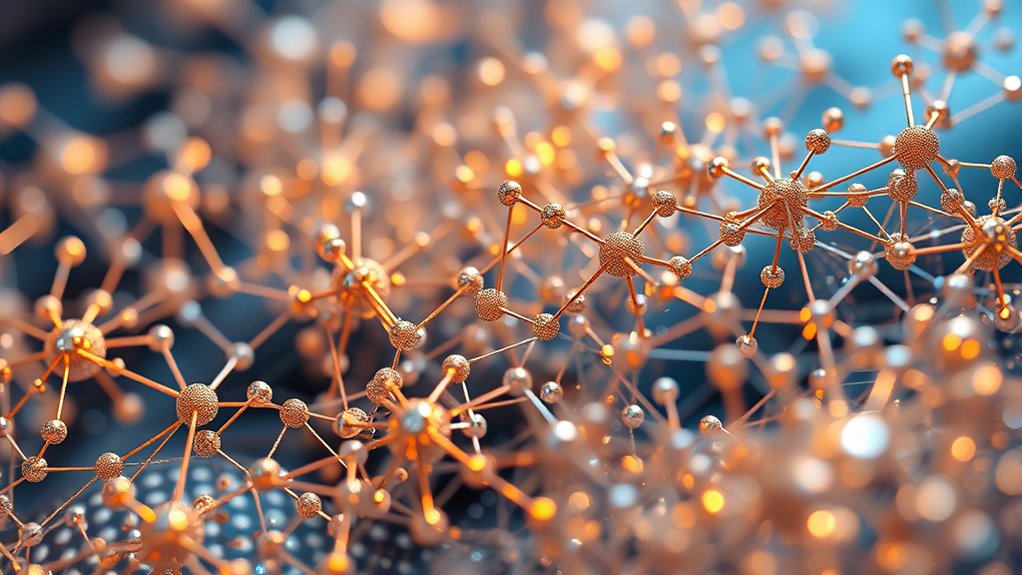
Building on advances in nanomachine architectures, optimizing charge transfer at the nanoscale plays a vital role in enhancing energy storage performance. To improve efficiency, focus on:
- Enhancing electrode surface area to increase contact points, facilitating faster electron flow.
- Engineering nanostructures with high conductivity pathways that reduce resistance.
- Developing interfaces with minimal energy barriers, ensuring smooth ion and electron movement.
- Employing nanoscale engineering techniques to precisely manipulate material properties for optimal charge transfer.
These strategies allow you to reduce energy losses during charge/discharge cycles, increase power density, and boost overall device efficiency. Nanoscale engineering enables precise control over material properties, which accelerates charge transfer processes. By implementing these approaches, you can substantially improve the responsiveness and capacity of batteries and supercapacitors, pushing energy storage technology closer to its full potential.
Durability and Longevity of Nanotech-Based Storage Devices

Ensuring the durability and longevity of nanotech-based storage devices is crucial for their practical application and long-term performance. Nanomaterials can degrade over time due to repeated charge and discharge cycles, causing capacity loss and reduced efficiency. To combat this, you should focus on developing stable nanostructures that resist mechanical and chemical degradation. Protective coatings can shield sensitive components from corrosion and physical wear. Additionally, optimizing the interface between nanomaterials and electrolytes helps prevent interface breakdowns. Regular maintenance and proper operating conditions also extend device life. By addressing these factors, you improve reliability and guarantee your energy storage solutions remain effective over prolonged periods, making them more viable for real-world applications. Nanomaterial stability is a key factor in preventing degradation and ensuring consistent performance. Longevity enhances user confidence and maximizes return on investment in nanotechnology-based energy systems.
Future Trends in Nanomachine-Driven Energy Technologies

As nanomachine-driven energy technologies continue to evolve, emerging trends point toward increased integration with smart grids and renewable energy systems. You’ll see nanomachines becoming essential for optimizing energy flow, storage, and conversion at a micro level. This will facilitate the development of home decoration inspiration that harmonizes technology and aesthetics in energy management. These advancements lead to more efficient, resilient power networks. Key future trends include:
- Enhanced self-healing nanomaterials that extend device lifespan and reliability.
- Smart nanomachines capable of real-time energy management and adaptive responses.
- Greater use of nanostructured interfaces to improve energy transfer and reduce losses.
These advancements will enable more seamless coordination between nanotech-based storage devices and larger energy infrastructures, powering smarter, more sustainable energy ecosystems.
Environmental Impact and Sustainability of Nanotech Energy Solutions
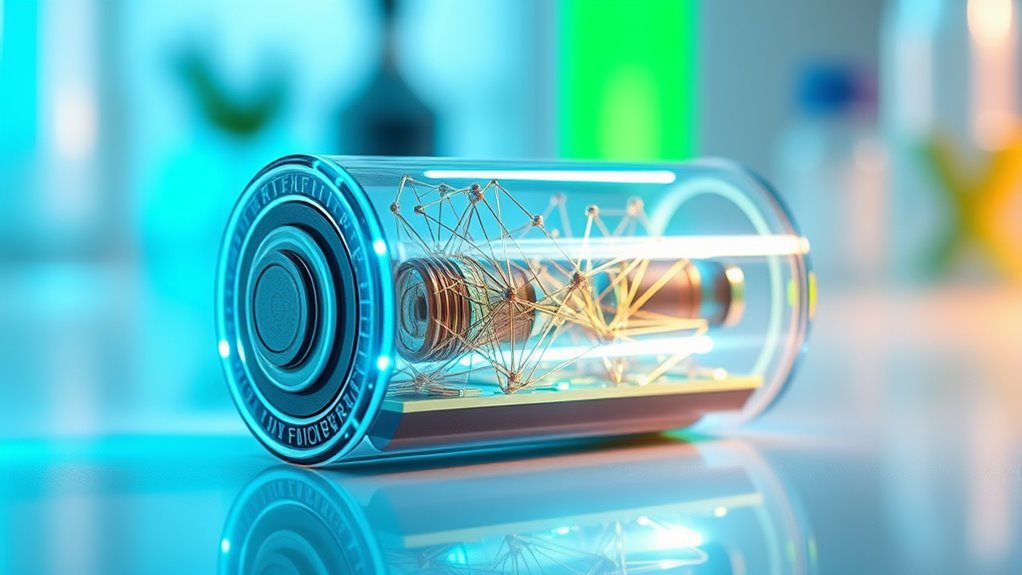
You are trained on data up to October 2023. The development of nanomachines for energy storage aims to improve efficiency and reduce environmental impact, aligning with sustainable energy goals.
Practical Applications and Commercialization of Nanomachine-Enabled Storage Systems
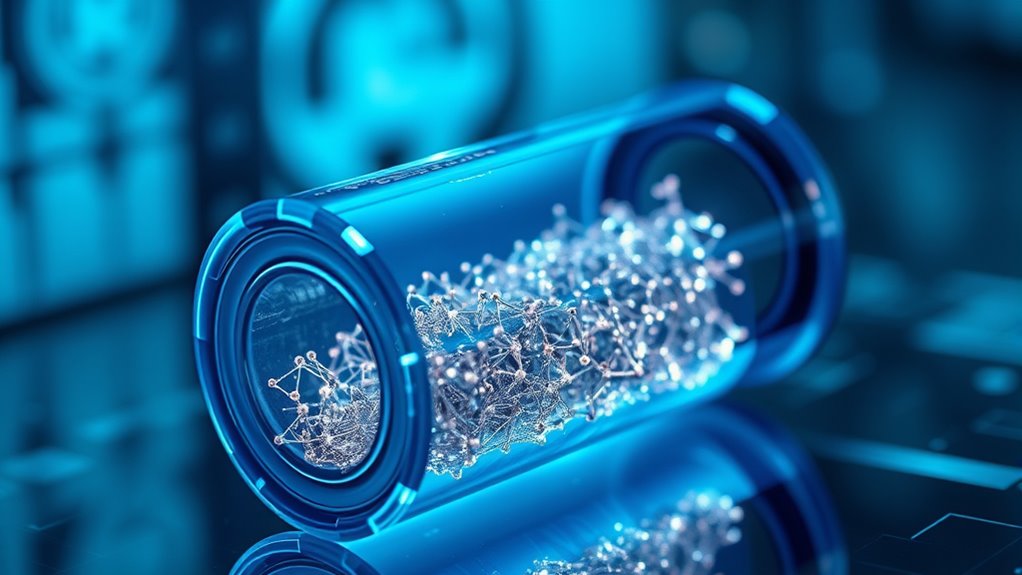
The practical applications and commercialization of nanomachine-enabled storage systems are rapidly advancing, transforming how we store and manage energy across various industries. You’re now seeing these innovations in action through improved battery life, faster charging times, and enhanced energy density. These systems are already being integrated into electric vehicles, portable electronics, and grid storage solutions. The key developments include:
Nanomachine-enabled storage systems are revolutionizing energy management in vehicles, electronics, and grid solutions.
- Deployment in electric vehicles for longer range and quicker charging
- Adoption in consumer electronics for lightweight, durable power sources
- Integration into large-scale grid storage to balance supply and demand efficiently
As nanomachine technology matures, expect wider commercial adoption, lower costs, and increased reliability, ultimately revolutionizing energy storage and pushing the boundaries of what’s possible in renewable energy, transportation, and portable devices. Enhanced energy density is a crucial benefit enabled by nanomachines, allowing for more compact and efficient storage solutions that were previously unattainable.
Frequently Asked Questions
How Do Nanomachines Influence the Safety of Energy Storage Devices?
Nanomachines improve the safety of energy storage devices by precisely controlling chemical reactions and heat management, reducing risks like overheating or short circuits. They monitor and adjust internal processes in real-time, preventing failures. This active regulation minimizes potential hazards, making batteries and supercapacitors safer for everyday use. With nanomachines, you get enhanced stability, longer lifespan, and peace of mind knowing that your energy storage system is less likely to fail dangerously.
What Are the Cost Implications of Integrating Nanotechnology in Batteries?
Integrating nanotechnology into batteries can initially raise costs due to advanced materials and manufacturing processes. However, it often leads to longer-lasting, more efficient batteries, which can save you money over time. As nanotech production scales up, prices typically decrease. While upfront expenses might be higher, the improved performance and durability can offset costs, making nanotech-enhanced batteries a cost-effective choice in the long run.
Can Nanomachines Repair or Regenerate Within Energy Storage Systems?
Imagine tiny repair crews inside your battery, constantly fixing tiny cracks and wear. Yes, nanomachines can repair or regenerate within energy storage systems. They act like microscopic surgeons, identifying damage and restoring functionality, which extends battery life and efficiency. For example, researchers are developing nanobots that can rebuild electrode material, reducing degradation. This innovation could revolutionize energy storage, making your devices more durable and reliable over time.
How Do Nanomaterials Affect the Environmental Footprint of Energy Devices?
Nanomaterials can reduce your energy device’s environmental footprint by making them more efficient and longer-lasting. They enable lighter, smaller batteries and supercapacitors that require fewer raw materials, cutting waste and energy consumption. Plus, their enhanced performance means fewer replacements and less disposal. By incorporating nanomaterials, you help lower harmful emissions and resource depletion, contributing to a greener, more sustainable energy future.
Are There Regulatory Challenges for Commercializing Nanotech-Based Energy Storage?
You’ll face massive regulatory hurdles when commercializing nanotech-based energy storage, like steering through a maze that seems endless. Governments impose strict safety and environmental standards because of potential health risks and environmental impacts. It’s not just paperwork; it’s a rigorous process that could slow down innovation and add significant costs. You must stay ahead of evolving regulations, prove safety, and demonstrate benefits, or your groundbreaking tech may never reach the market.
Conclusion
By harnessing nanomachines, you can profoundly boost energy storage efficiency. For example, nanomaterials can increase battery capacity by up to 30%, enabling longer-lasting devices and faster charging. As technology advances, these tiny innovations will reshape your energy solutions, making them more sustainable and reliable. Embracing nanotech in energy storage isn’t just a trend—it’s an essential step toward a cleaner, more efficient future that benefits everyone.
